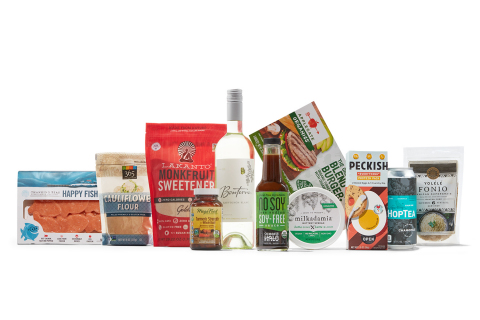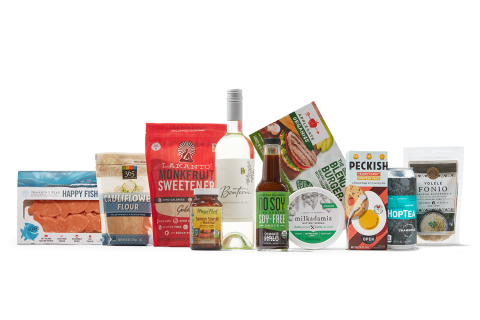AUSTIN, Texas--(BUSINESS WIRE)--Today, Whole Foods Market’s global buyers and experts revealed the most anticipated and innovative food trends for 2020 in the retailer’s fifth annual trends predictions announcement. Regenerative agriculture, West African foods, meat-plant blends and new varieties of flour are among the food influences and movements expected to take off in the next year.
Each year, more than 50 Whole Foods Market team members including local foragers, regional and global buyers and culinary experts thoughtfully compile the report based on decades of experience and expertise in product sourcing, studying consumer preferences and participating in food and wellness industry exhibitions worldwide.
While the retailer’s 2019 forecasted trends, including a rise in hemp-infused and topical CBD products, faux meat snacks and eco-conscious packaging, show no signs of slowing down, the 2020 trends represent a new crop of flavors and products for consumers to watch out for both in and outside the aisles of their local grocery stores.
Whole Foods Market’s top 10 food trend predictions for 2020:
-
Regenerative Agriculture
Farmers, producers, academics, government agencies, retailers and more are taking a closer look at how to use land and animal management practices to improve soil health and sequester carbon. While the term “regenerative agriculture” can have many definitions, in general it describes farming and grazing practices that restore degraded soil, improve biodiversity and increase carbon capture to create long-lasting environmental benefits, such as positively impacting climate change. You can help by seeking out brands that support regenerative practices.
Try the Trend: MegaFood Turmeric Strength for Whole Body; MegaFood B12 Energy Ginger Gummies; White Oak Pastures Grassfed Ground Beef; Zack’s Mighty Tortilla Chips; Cowgirl Creamery Mt. Tam; Soli Artisan Essential Oil Sacred Forest Collection: Palo Santo, Rosewood; Bonterra Sauvignon Blanc
-
Flour Power
As seasoned and amateur bakers alike look to scratch a creative itch in the kitchen, an array of interesting flours are entering the market making baking more inclusive and adventurous. Consumers on the baking bandwagon are seeking out ingredients used in traditional dishes, like teff flour used for Ethiopian injera. 2020 will bring more interesting fruit and vegetable flours (like banana!) into home pantries, with products like cauliflower flour in bulk and baking aisles, rather than already baked into crusts and snack products. Consumer packaged goods are getting in on the trend by replacing traditional alternative flours with tigernut flour in chips and snack foods, and tasty pastries made with seed flour blends. As consumers look for more ways to boost their bake, “super” flours delivering protein and fiber join the trend. Let the adventures in baking begin!
Try the Trend: Late July Tortilla Chips made with tigernut flour; 365 Everyday Value Cauliflower Flour; 365 Everyday Value Organic Coconut Flour; Gemini Superfoods Tigernut Flour; Superseed Life Donuts: Dark Chocolate, Wild Blueberry
-
Foods from West Africa
From indigenous superfoods to rich, earthy dishes, traditional West African flavors are popping up everywhere in food and in beverage. The trio of tomatoes, onions and chili peppers form a base for many West African dishes, and peanuts, ginger and lemongrass are all common additions. The 16 nations within West Africa share similar foods, but each have their own specialties based on subtle influences from the Middle East and Western Europe. Brands are looking to West Africa for its superfoods too like moringa and tamarind, and lesser known cereal grains sorghum, fonio, teff and millet. Chefs like Pierre Thiam are embracing the region too. His new Harlem restaurant, Teranga, is an ode to African culture through food.
Try the Trend: Kuli Kuli Organic Pure Moringa Vegetable Powder; Ginjan Organic Ginger Juice; Essie Spice Condiments, Mango Chili Medley; Yolélé Fonio
-
Out-of-the-Box, Into-the-Fridge Snacking
Life isn’t slowing down, but snack options are more than keeping up. The keyword is “fresh” in this new generation of grabbing and going—gone are the days when the only options were granola bars and mini pretzel bags. The refrigerated section is filling up with the kind of wholesome, fresh snacks typically prepared and portioned in advance at home: hard-boiled eggs with savory toppings, pickled vegetables, drinkable soups and mini dips and dippers of all kinds, all perfectly portioned and in convenient single-serve packaging. Even nutrition bars have made their way from the shelves to the chiller, thanks to the addition of fresh fruits and vegetables. These snacking innovations mean ingredients lists are shrinking and there’s a lot less guesswork in picking up a quick snack you can feel better about.
Try the Trend: Peckish Fresh Protein Packs: Eggs & Maple Waffles, Eggs & Fried Rice; Nona Lim drinkable soups: Vietnamese Pho Bone Broth, Coconut Lime Chicken Bone Broth; Perfect Bar Refrigerated Protein Bars: Peanut Butter, Coconut Peanut Butter, Dark Chocolate Chip Peanut Butter; Good Culture Organic Cottage Cheese single serving cups: Mixed Berry
-
Plant-Based, Beyond Soy
Tofu scrambles may always have a place at the vegan breakfast table, but in 2020 the trendiest brands are slowing down on soy, which has traditionally dominated the plant-based protein space. Some of the products touting “no soy” in the next year will be replacing it instead with innovative blends (like grains and mung beans) to mimic the creamy textures of yogurts and other dairy products. In the supplement aisle, brands are swapping soy for mung bean, hempseed, pumpkin, avocado, watermelon seed and golden chlorella, maintaining the smooth textures in vegan protein powders and bringing a spectrum of plant-based amino acids to the table. As the plant-based movement gains traction with flexitarian eaters, brands are looking to avoid as many of the top allergens as possible, so look for plant-based prepared foods (especially meat alternatives) and traditionally soy-based condiments going soy-less!
Try the Trend: Ocean’s Halo: Organic No Soy Soy-Free Sauce, Organic Soy-Free Vegan Fish Sauce; soy-free plant-based items coming to the Whole Foods Market Chef’s Case: Hearts of Palm Cakes, Smoky Vegetable Goulash, Ultra Green Vegan Spanakopita; Plant-Based Vega Protein & Energy: Classic Chocolate
-
Everything Butters and Spreads
Has (insert nut, seed, snack) been made into a butter yet? It’s likely to happen in 2020. Think seed butters beyond tahini – like watermelon seed butter – and seasonal products like pumpkin butter year-round. Nut butters beyond cashew, almond, and peanut (hello, macadamia) and even chickpea butters (no, it’s not a new name for hummus). Look for creamy vegan spreads perfect for toast, crackers, bagels, and celery sticks that get their full flavors from trending superfoods like pili. It helps the trend that spreads and butters are touting paleo- and keto-friendly attributes, but transparency is also a key player in this trend. Many brands are looking to either eliminate the use of palm oil or promote a Responsibly Sourced Palm Oil certification and use nuts that are grown in ways with less likelihood for environmental impact.
Try the Trend: FBOMB Macadamia Nut Butter squeeze pouch: Salted Chocolate; 88 Acres: Watermelon Seed Butter, Roasted Pumpkin Seed Butter; Milkadamia Butta-Bing Butta-Boom Buttery Spread: Salted, Unsalted
-
Rethinking the Kids’ Menu
Are the days of picky eaters numbered? Judging from the number of kids’ cooking and baking competitions on TV, kids are kitchen-savvier than ever. By 2026, 80% of millennials will have children, and many parents are introducing their kids to more adventurous foods — with great results. (Seeing kids chowing down alongside parents at the Whole Foods Market sushi bar is a common sight.) Food brands are taking notice for the next generation – possibly our first true “foodies” – expanding the menu beyond nostalgic foods with better-for-you ingredients and organic chicken nuggets. They’re bridging the gap from old-school basic kids’ menus and taking more sophisticated younger palates into consideration. Think non-breaded salmon fish sticks. Foods that are fermented, spiced or rich in umami flavors. Colorful pastas in fun shapes made from alternative flours. Maybe it’s time adults start taking some cues from the kids’ menu.
Try the Trend: gimMe Organic Premium Roasted Seaweed: Sea Salt; Whole Foods Market olive bar; Happy Fish Responsibly Farmed Salmon fish-shaped frozen salmon patties; Whole Foods Market Limited Edition Lemon Basil Chia Shortbread Cookies; Serenity Kids 100% Wild Caught Coho Salmon puree pouch; Cerebelly Organic Pea Basil puree pouch; Whole Foods Market Goat Cheese Crumbles
-
Not-So-Simple Sugars
Sure, there’s sugar. But for those seeking sweetness outside of the usual suspects like sugar, stevia, honey and maple syrup, there’s lots more to choose from for your cooking, baking and tea- or coffee-stirring needs. Syrupy reductions from fruit sources like monk fruit, pomegranates, coconut and dates are one way to add concentrated, unique flavors into recipes for desserts, meat glazes and marinades. Sweet syrups made from starches like sorghum and sweet potato can be compared to the deep flavors of molasses or honey, and can be used for baking and sweetening beverages. Swerve, a cup-for-cup zero-calorie non-glycemic replacement for sugar, combines erythritol with ingredients from fruit and starchy root vegetables to produce a sweetener that’s available in granular, confectioners’ and brown versions.
Try the Trend: Just Pomegranate Syrup; Lakanto Monk Fruit Sweeteners; D’vash Sweet Potato Nectar; Birch Benders Monk Fruit Sweetened Pancake Syrup: Classic Maple; Swerve sweeteners
-
Meat-Plant Blends
Butchers and meat brands won’t be left out of the “plant-based” craze in 2020, but they’re not going vegetarian. Chefs across the country have been on board with the trend for years through James Beard Foundation’s The Blended Burger Project, a movement that strives to make the iconic burger “better for customers and for the planet” by blending in at least 25% fresh mushrooms. For the health-conscious at-home chef, adding plant-based ingredients to meatballs and burgers has an added bonus – it’s budget-friendly! Major brands like Applegate are seeing if meat-eating consumers will swap a traditional beef burger for one with 30% plant-based ingredients, touting benefits of less fat and cholesterol when compared to USDA data for regular ground beef (check out Applegate’s website for nutritional comparison information). And other brands are taking note, too, with products like the Lika Plus Burger made using 75% ground beef blended with 25% Lika Plus (wheat, mushroom, barley yeast and water), showing up at meat counters in Whole Foods Market’s Southwest region. Flexitarians looking to strike a tasty balance between meats and plants can expect more blended products in their future.
Try the Trend: Applegate’s The Great Organic Blended Burger; Lika Plus Blended Burger; Beef, quinoa, vegetable meatballs; The Blended Burger Project winning recipes
-
Zero-Proof Drinks
With so many consumers seeking out alternatives to alcohol, unique non-alcoholic options are popping up everywhere, from menus at the world’s most acclaimed bars to specialty stores. Many of these beverages seek to re-create classic cocktail flavors using distilling methods typically reserved for alcohol, creating an alternative to liquor meant to be used with a mixer rather than a drink on its own. Think alt-gin for gin and tonics and botanical-infused faux spirits for a faux martini. Add to that options enjoyed straight from the bottle or can, like hops-infused sparkling waters and zero-proof apertifs, and you can be sure guests avoiding the bar cart will never get bored.
Try the Trend: HopTea Sparkling Teas: The Really Hoppy One made with black tea, The Green Tea One made with green tea, The Calm One made with chamomile; Heineken 0.0; Athletic Brewing Company non-alcoholic brews: Run Wild non-alcoholic IPA, Upside Dawn non-alcoholic Golden Ale; Kater Wingman longneck sparkling waters
“Try the Trend” products and brands illustrating 2020 food trends include a variety of products available now or coming to Whole Foods Market stores in 2020 for either local or national distribution. Shoppers can seek out trending products by visiting wholefoodsmarket.com/products.
About Whole Foods Market
For 40 years, Whole Foods Market has been the world’s leading natural and organic foods retailer. As the first national certified organic grocer, Whole Foods Market has more than 500 stores in the United States, Canada and the United Kingdom. To learn more about Whole Foods Market, please visit https://media.wholefoodsmarket.com/.




